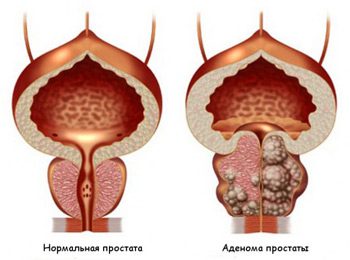Contents
Prostate adenoma: causes, symptoms and treatments
Benign and very common pathology, prostate adenoma affects a quarter of men between 55 and 60 years old and more than one in two men between 66 and 70 years old. What are the symptoms ? How to diagnose and treat it? The answers of Inès Dominique, urologist
Definition of prostate adenoma
Also called benign prostatic hyperplasia (BPH), prostate adenoma is a gradual increase in prostate size. “This increase in volume results from the proliferation of prostate cells linked to aging” says Dr Dominique.
The frequency of this pathology increases with age and affects nearly 90% of men over 80 to varying degrees. “It is a chronic pathology, evolving over many years, but which is not linked to prostate cancer” adds the urologist.
Causes and risk factors for prostate adenoma
The mechanism of development of prostate adenoma is poorly understood.
“Several theories have been developed: hormonal mechanisms – especially via DHT – can be involved, or an imbalance between the growth and destruction of prostate cells” indicates Inès Dominique.
The metabolic syndrome would however be a real risk factor, since the probability of being treated for a prostate adenoma is doubled in patients with metabolic syndrome.
Symptoms of prostate adenoma
Sometimes the prostate adenoma is completely asymptomatic and discovered incidentally during a medical imaging exam. But most often, it causes urinary symptoms caused by compression of the urethra by the abnormally developed prostate.
“Symptoms of LUTS (urinary tract disorders) can be felt by the patient” describes in particular the urologist.
The International Continence Society (ICS) divides these symptoms into three categories:
Disorders of the filling phase
“This is pollakiuria, namely the need to go urinate often, which can be day or night as well as urination emergencies” describes Dr Dominique.
Disorders of the emptying phase
“It is the need to push to urinate, called dysuria, the difficulty in initiating urination or even a choppy and / or weak urine stream” continues the specialist.
Post-voiding phase disorders
“These are the late drops or the impression of incomplete emptying of the bladder.”
It also happens that the prostate adenoma causes sexual dysfunction, including a weakened ejaculatory jet.
Diagnosis of prostate adenoma
The diagnosis of prostate adenoma is based on questioning the patient for possible urinary symptoms, physical examination with digital rectal examination and sometimes, if necessary, imaging and biology.
“The digital rectal exam is used to assess the size and consistency of the prostate to also ensure that there is no associated prostate cancer. This is a painless and risk-free examination ” describes Dr Dominique.
In case of doubt, a flow measurement can be performed: the patient must then urinate in a “specialized” toilet which allows the urinary flow to be assessed.
Imaging is based on reno-vesico-prostatic ultrasound. “It makes it possible to evaluate the volume of the prostate, to verify the absence of a bladder calculus or bladder anomaly and also to verify the absence of renal repercussions” explains the specialist. This ultrasound also makes it possible to check the correct emptying of the bladder during urination.
Finally, the biology is based on the determination of the prostate hormone called PSA – in order to rule out possible prostate cancer – and on an assay of renal function via the analysis of creatinine.
Complications of prostate adenoma
The prostate adenoma may be benign, it must be monitored and even treated to prevent possible complications.
“Benign prostatic hyperplasia can indeed create a bladder obstruction preventing its proper emptying, itself the cause of several types of complications: Urinary tract infection (prostatitis), hematuria (bleeding in the urine) bladder calculus, retention acute urine or kidney failure “ explains Dr Inès Dominique.
Treatments for prostate adenoma
As long as the patient does not feel discomfort and presents no complications, the initiation of treatment is not necessary.
“On the other hand, if the patient is inconvenienced at the urinary level, symptomatic drug treatments exist with very good efficiency” insists the urologist.
As a first-line treatment, and in the absence of contraindications, the doctor offers alpha-blockers (Alfuzosine®, Silodosine® etc.) to improve the symptoms. If they are not effective enough, we then propose 5-alpha-reductase inhibitors (Finasteride®, dutasteride®) which act by reducing the size of the prostate over the long term.
“If drug treatments are not effective or the patient has complications from BPH, surgical management may be offered. The interventions are then based on the clearing of the urethra “ specifies the specialist
These interventions can be performed through the urethra by endoscopy with different techniques: “By conventional electrical resection or by laser or by bipolar enucleation” explains Dr Dominique.
If the prostate volume is too large, open surgery may be proposed, “We are talking about high-way adenomectomy” specifies the specialist.
Prevention of prostate adenoma
So far, no preventive measure has proven effective for the development of BPH.
“The most important prevention is that of complications from BPH which can be serious and sometimes permanent, such as chronic kidney disease. It is therefore essential to carefully monitor patients with BPH even when they are non-symptomatic in order to detect poor bladder emptying ” explains the urologist.
The hygiene rules to follow
In addition, rules of hygiene of life can be respected in order to anticipate possible complications. In particular, patients are recommended:
- To limit the consumption of liquids in the evening: soups, herbal teas, water, drinks
- To reduce as much as possible the intake of caffeine or alcohol,
- To fight against constipation, with a diet rich in fruits, vegetables, whole grains and legumes,
- To practice regular physical activity.










